Skid Control ECU Communication Stop Mode
DESCRIPTION
|
Detection Item | Symptom |
Trouble Area |
| Skid Control ECU Communication Stop Mode |
Any of the following conditions are met:
- Communication stop for "Skid Control (ABS/VSC/TRAC)" is indicated on the "Communication Bus Check" screen of the Techstream.
Click here 
- Communication stop history for "Skid Control (ABS/VSC/TRAC)" is
indicated on the "Communication Bus Check (Detail)" screen of the
Techstream. (The Lost Communication Time value for "Skid Control
(ABS/VSC/TRAC)" is 6 or more.)
Click here 
- Communication system DTCs (DTCs that start with U) that correspond to
"Skid Control ECU Communication Stop Mode" in "DTC Combination Table"
are output.
Click here 
|
- Brake booster with master cylinder assembly branch line or connector
- Power source circuit of brake booster with master cylinder assembly
- Brake booster with master cylinder assembly ground circuit
- Brake booster with master cylinder assembly
|
WIRING DIAGRAM
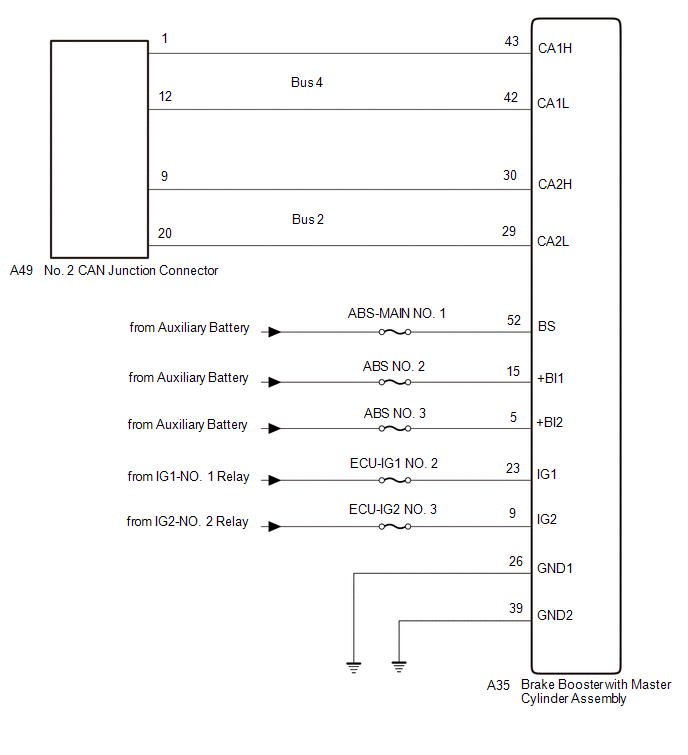
CAUTION / NOTICE / HINT
CAUTION:
When performing the confirmation driving pattern, obey all speed limits and traffic laws.
NOTICE:
HINT:
- Before disconnecting related connectors for inspection, push in on each
connector body to check that the connector is not loose or disconnected.
- When a connector is disconnected, check that the terminals and connector body are not cracked, deformed or corroded.
PROCEDURE
|
1. | CHECK FOR OPEN IN CAN BUS LINES (BRAKE BOOSTER WITH MASTER CYLINDER ASSEMBLY BRANCH LINE) |
(a) Disconnect the cable from the negative (-) auxiliary battery terminal.
(b) Disconnect the A35 brake booster with master cylinder assembly connector.
| (c) Measure the resistance according to the value(s) in the table below.
Standard Resistance: Bus 2 Branch Lines |
Tester Connection | Condition |
Specified Condition | |
A35-30 (CA2H) - A35-29 (CA2L) |
Cable disconnected from negative (-) auxiliary battery terminal |
54 to 69 Ω | Bus 4 Branch Lines |
Tester Connection | Condition |
Specified Condition | |
A35-43 (CA1H) - A35-42 (CA1L) |
Cable disconnected from negative (-) auxiliary battery terminal |
54 to 69 Ω | |
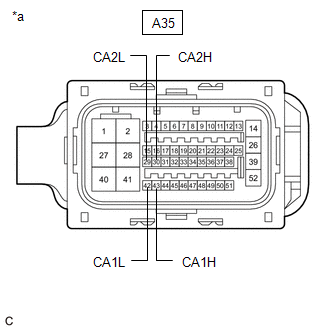 |
|
*a | Front view of wire harness connector
(to Brake Booster with Master Cylinder Assembly) | | |
| NG |
 | REPAIR OR REPLACE CAN BRANCH LINES OR CONNECTOR (BRAKE BOOSTER WITH MASTER CYLINDER ASSEMBLY) |
|
OK |
 | |
| 2. |
CHECK HARNESS AND CONNECTOR (POWER SOURCE CIRCUIT) |
| (a) Measure the resistance according to the value(s) in the table below.
Standard Resistance: |
Tester Connection | Condition |
Specified Condition | |
A35-26 (GND1) - Body ground |
Cable disconnected from negative (-) auxiliary battery terminal |
Below 1 Ω | |
A35-39 (GND2) - Body ground |
Cable disconnected from negative (-) auxiliary battery terminal |
Below 1 Ω | |
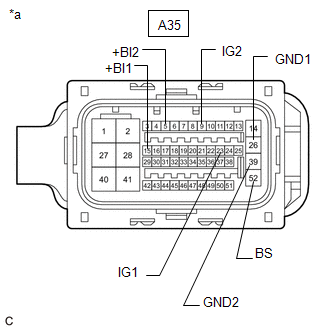 |
|
*a | Front view of wire harness connector
(to Brake Booster with Master Cylinder Assembly) | | |
(b) Reconnect the cable to the negative (-) auxiliary battery terminal.
(c) Measure the voltage according to the value(s) in the table below.
Standard Voltage:
|
Tester Connection | Condition |
Specified Condition |
|
A35-5 (+BI2) - Body ground |
Power switch off | 11 to 14 V |
|
A35-15 (+BI1) - Body ground |
Power switch off | 11 to 14 V |
|
A35-52 (BS) - Body ground |
Power switch off | 11 to 14 V |
|
A35-9 (IG2) - Body ground |
Power switch on (IG) |
11 to 14 V |
|
A35-23 (IG1) - Body ground |
Power switch on (IG) |
11 to 14 V |
| OK |
 | REPLACE BRAKE BOOSTER WITH MASTER CYLINDER ASSEMBLY |
| NG |
 | REPAIR OR REPLACE HARNESS OR CONNECTOR (POWER SOURCE CIRCUIT) |
Steering Angle Sensor Communication Stop Mode
DESCRIPTION
|
Detection Item | Symptom |
Trouble Area |
| Steering Angle Sensor Communication Stop Mode |
Any of the following conditions are met:
- Communication stop for "Spiral cable (Steering Angle Sensor)" is
indicated on the "Communication Bus Check" screen of the Techstream.
Click here 
- Communication stop history for "Spiral cable (Steering Angle Sensor)" is
indicated on the "Communication Bus Check (Detail)" screen of the
Techstream. (The Lost Communication Time value for "Spiral cable
(Steering Angle Sensor)" is 6 or more.)
Click here 
- Communication system DTCs (DTCs that start with U) that correspond to
"Steering Angle Sensor Communication Stop Mode" in "DTC Combination
Table" are output.
Click here 
|
- Steering sensor branch line or connector
- Power source circuit of steering sensor
- Steering sensor ground circuit
- Steering sensor
|
WIRING DIAGRAM
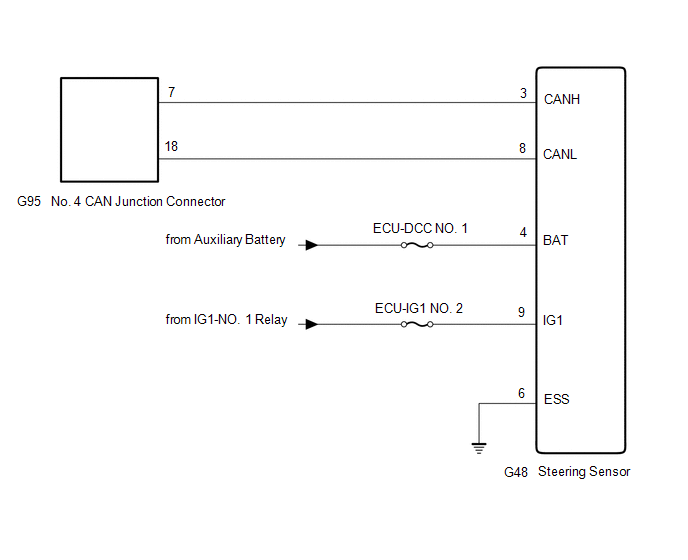
CAUTION / NOTICE / HINT
CAUTION:
When performing the confirmation driving pattern, obey all speed limits and traffic laws.
NOTICE:
HINT:
- Before disconnecting related connectors for inspection, push in on each
connector body to check that the connector is not loose or disconnected.
- When a connector is disconnected, check that the terminals and connector body are not cracked, deformed or corroded.
PROCEDURE
|
1. | CHECK FOR OPEN IN CAN BUS LINES (STEERING SENSOR BRANCH LINE) |
(a) Disconnect the cable from the negative (-) auxiliary battery terminal.
(b) Disconnect the G48 steering sensor connector.
| (c) Measure the resistance according to the value(s) in the table below.
Standard Resistance: |
Tester Connection | Condition |
Specified Condition | |
G48-3 (CANH) - G48-8 (CANL) |
Cable disconnected from negative (-) auxiliary battery terminal |
54 to 69 Ω | |
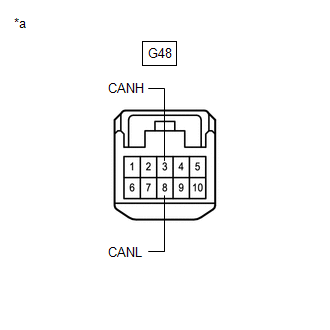 |
|
*a | Front view of wire harness connector
(to Steering Sensor) | | |
| NG |
 | REPAIR OR REPLACE CAN BRANCH LINES OR CONNECTOR (STEERING SENSOR) |
|
OK |
 | |
| 2. |
CHECK HARNESS AND CONNECTOR (POWER SOURCE CIRCUIT) |
| (a) Measure the resistance according to the value(s) in the table below.
Standard Resistance: |
Tester Connection | Condition |
Specified Condition | |
G48-6 (ESS) - Body ground |
Cable disconnected from negative (-) auxiliary battery terminal |
Below 1 Ω | |
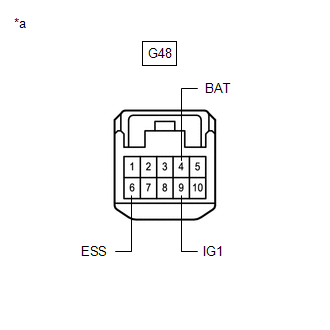 |
|
*a | Front view of wire harness connector
(to Steering Sensor) | | |
(b) Reconnect the cable to the negative (-) auxiliary battery terminal.
(c) Measure the voltage according to the value(s) in the table below.
Standard Voltage:
|
Tester Connection | Condition |
Specified Condition |
|
G48-4 (BAT) - Body ground |
Power switch off | 11 to 14 V |
|
G48-9 (IG1) - Body ground |
Power switch on (IG) |
11 to 14 V |
| OK |
 | REPLACE STEERING SENSOR |
| NG |
 | REPAIR OR REPLACE HARNESS OR CONNECTOR (POWER SOURCE CIRCUIT) |
System Description
SYSTEM DESCRIPTION
BRIEF DESCRIPTION
(a)
The Controller Area Network (CAN) is a serial data communication system
for real time application. It is a vehicle multiplex communication
system which has a high communication speed and the ability to detect
malfunctions.

(b)
Using the CANH and CANL bus lines as a pair, CAN communication is
performed using a voltage differential. (A base voltage is applied to
the pair of lines and a voltage differential is created when
communicating.)
(c) Many ECUs or sensors installed to the vehicle operate by sharing information and communicating with each other.
(d) 2 resistors which are necessary for communication are used in a CAN bus main line.

DEFINITION OF TERMS
(a) Central bus
(1) The central bus is a term used to describe all buses directly connected to the central gateway ECU (network gateway ECU).
HINT:
A bus is displayed as Bus on the "Communication Bus Check" screen of the Techstream.
(b) Sub bus
(1)
A sub bus is a bus that has a gateway function equipped ECU in order to
communicate with the central bus and other sub buses.
HINT:
- A sub bus is displayed as Sub bus on the "Communication Bus Check" screen of the Techstream.
- When Sub bus is selected on the "Communication Bus Check" screen, ECUs
and sensors connected to non-CAN networks such as LIN may also be
displayed in addition to the ECUs and sensors connected to sub buses in
the CAN network.
(c) Local bus
(1)
A local bus is a bus that does not have the ability to communicate with
other buses. ECUs and sensors on a local bus can only communicate with
other ECUs and sensors on the same bus.
(d) CAN J/C
(1) A CAN junction connector is a connector that connects branch lines to a main bus.
(e) Main bus
(1) A main bus line is the wire harness that runs between the 2 terminating resistors of a bus.
(f) Branch
(1) A branch line is a wire harness that connects an ECU or sensor to a main bus line.
(g) Terminating resistors
(1)
Terminating resistors which maintain a stable signal inside the CAN bus
are installed. 2 resistors of 120 Ω each located at each end of the bus
are necessary.



























